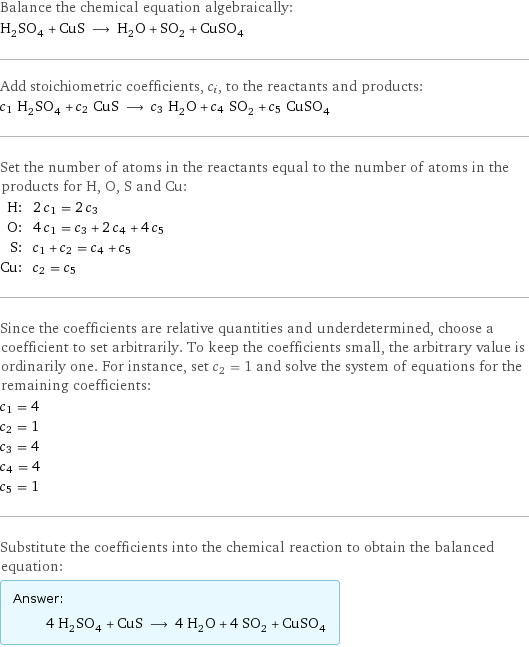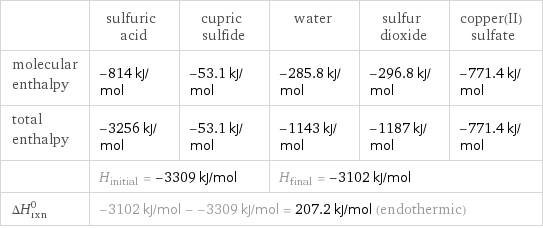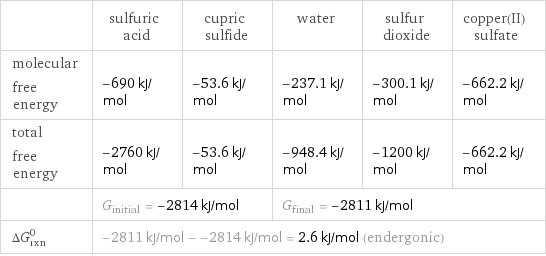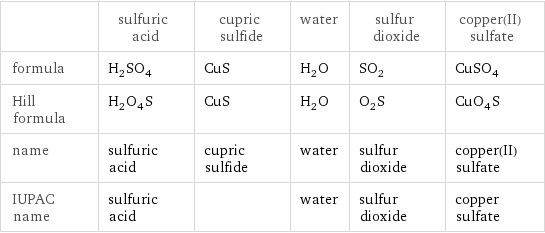Input interpretation

H_2SO_4 sulfuric acid + CuS cupric sulfide ⟶ H_2O water + SO_2 sulfur dioxide + CuSO_4 copper(II) sulfate
Balanced equation

Balance the chemical equation algebraically: H_2SO_4 + CuS ⟶ H_2O + SO_2 + CuSO_4 Add stoichiometric coefficients, c_i, to the reactants and products: c_1 H_2SO_4 + c_2 CuS ⟶ c_3 H_2O + c_4 SO_2 + c_5 CuSO_4 Set the number of atoms in the reactants equal to the number of atoms in the products for H, O, S and Cu: H: | 2 c_1 = 2 c_3 O: | 4 c_1 = c_3 + 2 c_4 + 4 c_5 S: | c_1 + c_2 = c_4 + c_5 Cu: | c_2 = c_5 Since the coefficients are relative quantities and underdetermined, choose a coefficient to set arbitrarily. To keep the coefficients small, the arbitrary value is ordinarily one. For instance, set c_2 = 1 and solve the system of equations for the remaining coefficients: c_1 = 4 c_2 = 1 c_3 = 4 c_4 = 4 c_5 = 1 Substitute the coefficients into the chemical reaction to obtain the balanced equation: Answer: | | 4 H_2SO_4 + CuS ⟶ 4 H_2O + 4 SO_2 + CuSO_4
Structures

+ ⟶ + +
Names

sulfuric acid + cupric sulfide ⟶ water + sulfur dioxide + copper(II) sulfate
Reaction thermodynamics
Enthalpy

| sulfuric acid | cupric sulfide | water | sulfur dioxide | copper(II) sulfate molecular enthalpy | -814 kJ/mol | -53.1 kJ/mol | -285.8 kJ/mol | -296.8 kJ/mol | -771.4 kJ/mol total enthalpy | -3256 kJ/mol | -53.1 kJ/mol | -1143 kJ/mol | -1187 kJ/mol | -771.4 kJ/mol | H_initial = -3309 kJ/mol | | H_final = -3102 kJ/mol | | ΔH_rxn^0 | -3102 kJ/mol - -3309 kJ/mol = 207.2 kJ/mol (endothermic) | | | |
Gibbs free energy

| sulfuric acid | cupric sulfide | water | sulfur dioxide | copper(II) sulfate molecular free energy | -690 kJ/mol | -53.6 kJ/mol | -237.1 kJ/mol | -300.1 kJ/mol | -662.2 kJ/mol total free energy | -2760 kJ/mol | -53.6 kJ/mol | -948.4 kJ/mol | -1200 kJ/mol | -662.2 kJ/mol | G_initial = -2814 kJ/mol | | G_final = -2811 kJ/mol | | ΔG_rxn^0 | -2811 kJ/mol - -2814 kJ/mol = 2.6 kJ/mol (endergonic) | | | |
Equilibrium constant
![Construct the equilibrium constant, K, expression for: H_2SO_4 + CuS ⟶ H_2O + SO_2 + CuSO_4 Plan: • Balance the chemical equation. • Determine the stoichiometric numbers. • Assemble the activity expression for each chemical species. • Use the activity expressions to build the equilibrium constant expression. Write the balanced chemical equation: 4 H_2SO_4 + CuS ⟶ 4 H_2O + 4 SO_2 + CuSO_4 Assign stoichiometric numbers, ν_i, using the stoichiometric coefficients, c_i, from the balanced chemical equation in the following manner: ν_i = -c_i for reactants and ν_i = c_i for products: chemical species | c_i | ν_i H_2SO_4 | 4 | -4 CuS | 1 | -1 H_2O | 4 | 4 SO_2 | 4 | 4 CuSO_4 | 1 | 1 Assemble the activity expressions accounting for the state of matter and ν_i: chemical species | c_i | ν_i | activity expression H_2SO_4 | 4 | -4 | ([H2SO4])^(-4) CuS | 1 | -1 | ([CuS])^(-1) H_2O | 4 | 4 | ([H2O])^4 SO_2 | 4 | 4 | ([SO2])^4 CuSO_4 | 1 | 1 | [CuSO4] The equilibrium constant symbol in the concentration basis is: K_c Mulitply the activity expressions to arrive at the K_c expression: Answer: | | K_c = ([H2SO4])^(-4) ([CuS])^(-1) ([H2O])^4 ([SO2])^4 [CuSO4] = (([H2O])^4 ([SO2])^4 [CuSO4])/(([H2SO4])^4 [CuS])](../image_source/f917f525625439411d590f1a92b1e725.png)
Construct the equilibrium constant, K, expression for: H_2SO_4 + CuS ⟶ H_2O + SO_2 + CuSO_4 Plan: • Balance the chemical equation. • Determine the stoichiometric numbers. • Assemble the activity expression for each chemical species. • Use the activity expressions to build the equilibrium constant expression. Write the balanced chemical equation: 4 H_2SO_4 + CuS ⟶ 4 H_2O + 4 SO_2 + CuSO_4 Assign stoichiometric numbers, ν_i, using the stoichiometric coefficients, c_i, from the balanced chemical equation in the following manner: ν_i = -c_i for reactants and ν_i = c_i for products: chemical species | c_i | ν_i H_2SO_4 | 4 | -4 CuS | 1 | -1 H_2O | 4 | 4 SO_2 | 4 | 4 CuSO_4 | 1 | 1 Assemble the activity expressions accounting for the state of matter and ν_i: chemical species | c_i | ν_i | activity expression H_2SO_4 | 4 | -4 | ([H2SO4])^(-4) CuS | 1 | -1 | ([CuS])^(-1) H_2O | 4 | 4 | ([H2O])^4 SO_2 | 4 | 4 | ([SO2])^4 CuSO_4 | 1 | 1 | [CuSO4] The equilibrium constant symbol in the concentration basis is: K_c Mulitply the activity expressions to arrive at the K_c expression: Answer: | | K_c = ([H2SO4])^(-4) ([CuS])^(-1) ([H2O])^4 ([SO2])^4 [CuSO4] = (([H2O])^4 ([SO2])^4 [CuSO4])/(([H2SO4])^4 [CuS])
Rate of reaction
![Construct the rate of reaction expression for: H_2SO_4 + CuS ⟶ H_2O + SO_2 + CuSO_4 Plan: • Balance the chemical equation. • Determine the stoichiometric numbers. • Assemble the rate term for each chemical species. • Write the rate of reaction expression. Write the balanced chemical equation: 4 H_2SO_4 + CuS ⟶ 4 H_2O + 4 SO_2 + CuSO_4 Assign stoichiometric numbers, ν_i, using the stoichiometric coefficients, c_i, from the balanced chemical equation in the following manner: ν_i = -c_i for reactants and ν_i = c_i for products: chemical species | c_i | ν_i H_2SO_4 | 4 | -4 CuS | 1 | -1 H_2O | 4 | 4 SO_2 | 4 | 4 CuSO_4 | 1 | 1 The rate term for each chemical species, B_i, is 1/ν_i(Δ[B_i])/(Δt) where [B_i] is the amount concentration and t is time: chemical species | c_i | ν_i | rate term H_2SO_4 | 4 | -4 | -1/4 (Δ[H2SO4])/(Δt) CuS | 1 | -1 | -(Δ[CuS])/(Δt) H_2O | 4 | 4 | 1/4 (Δ[H2O])/(Δt) SO_2 | 4 | 4 | 1/4 (Δ[SO2])/(Δt) CuSO_4 | 1 | 1 | (Δ[CuSO4])/(Δt) (for infinitesimal rate of change, replace Δ with d) Set the rate terms equal to each other to arrive at the rate expression: Answer: | | rate = -1/4 (Δ[H2SO4])/(Δt) = -(Δ[CuS])/(Δt) = 1/4 (Δ[H2O])/(Δt) = 1/4 (Δ[SO2])/(Δt) = (Δ[CuSO4])/(Δt) (assuming constant volume and no accumulation of intermediates or side products)](../image_source/74184f4e3d1f9d76470850468f8665b9.png)
Construct the rate of reaction expression for: H_2SO_4 + CuS ⟶ H_2O + SO_2 + CuSO_4 Plan: • Balance the chemical equation. • Determine the stoichiometric numbers. • Assemble the rate term for each chemical species. • Write the rate of reaction expression. Write the balanced chemical equation: 4 H_2SO_4 + CuS ⟶ 4 H_2O + 4 SO_2 + CuSO_4 Assign stoichiometric numbers, ν_i, using the stoichiometric coefficients, c_i, from the balanced chemical equation in the following manner: ν_i = -c_i for reactants and ν_i = c_i for products: chemical species | c_i | ν_i H_2SO_4 | 4 | -4 CuS | 1 | -1 H_2O | 4 | 4 SO_2 | 4 | 4 CuSO_4 | 1 | 1 The rate term for each chemical species, B_i, is 1/ν_i(Δ[B_i])/(Δt) where [B_i] is the amount concentration and t is time: chemical species | c_i | ν_i | rate term H_2SO_4 | 4 | -4 | -1/4 (Δ[H2SO4])/(Δt) CuS | 1 | -1 | -(Δ[CuS])/(Δt) H_2O | 4 | 4 | 1/4 (Δ[H2O])/(Δt) SO_2 | 4 | 4 | 1/4 (Δ[SO2])/(Δt) CuSO_4 | 1 | 1 | (Δ[CuSO4])/(Δt) (for infinitesimal rate of change, replace Δ with d) Set the rate terms equal to each other to arrive at the rate expression: Answer: | | rate = -1/4 (Δ[H2SO4])/(Δt) = -(Δ[CuS])/(Δt) = 1/4 (Δ[H2O])/(Δt) = 1/4 (Δ[SO2])/(Δt) = (Δ[CuSO4])/(Δt) (assuming constant volume and no accumulation of intermediates or side products)
Chemical names and formulas

| sulfuric acid | cupric sulfide | water | sulfur dioxide | copper(II) sulfate formula | H_2SO_4 | CuS | H_2O | SO_2 | CuSO_4 Hill formula | H_2O_4S | CuS | H_2O | O_2S | CuO_4S name | sulfuric acid | cupric sulfide | water | sulfur dioxide | copper(II) sulfate IUPAC name | sulfuric acid | | water | sulfur dioxide | copper sulfate